MERCEDES-BENZ SPRINTER 2014 MY14 Operator’s Manual
Manufacturer: MERCEDES-BENZ, Model Year: 2014, Model line: SPRINTER, Model: MERCEDES-BENZ SPRINTER 2014Pages: 338, PDF Size: 6.78 MB
Page 51 of 338
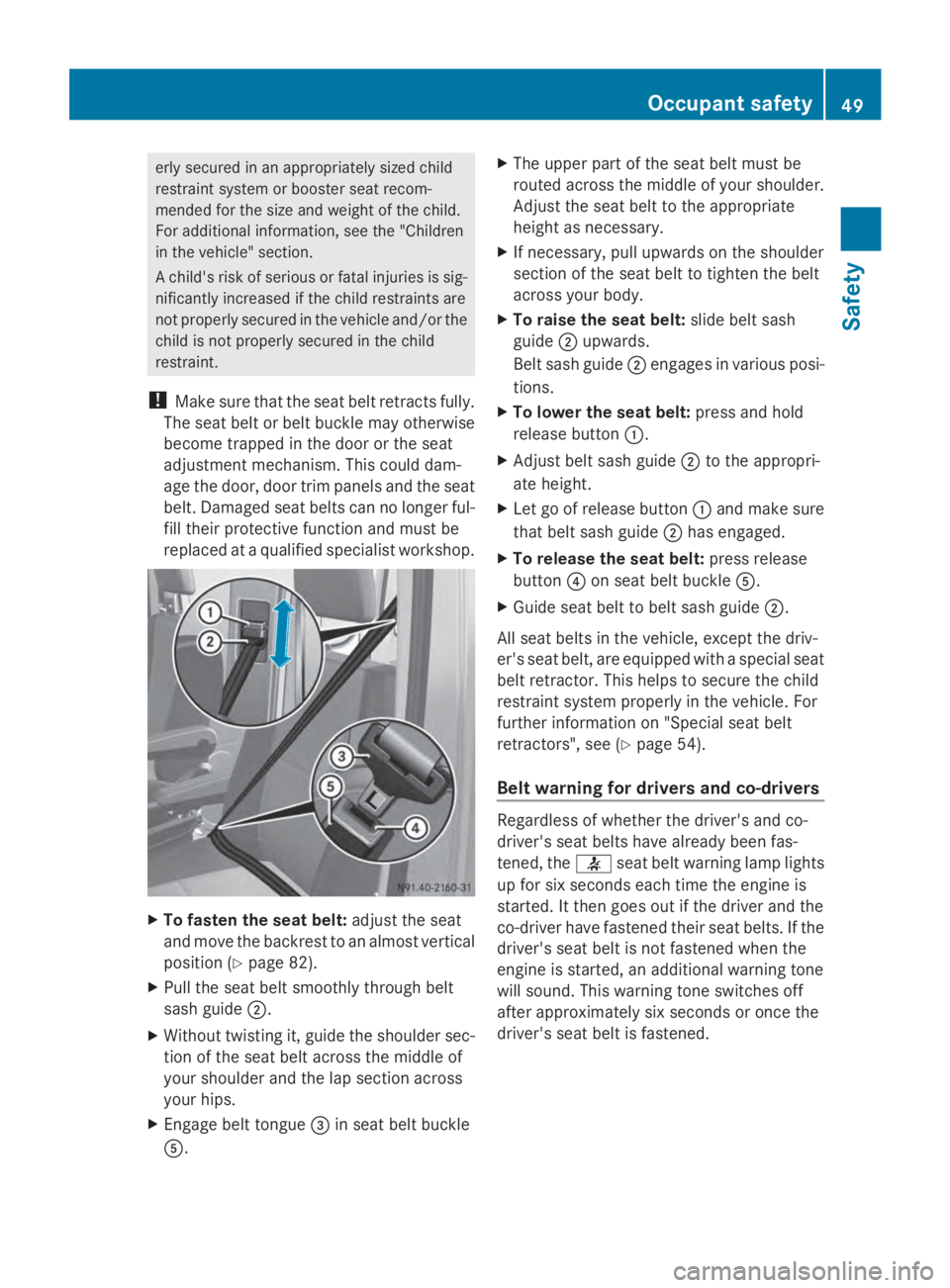
erly secured in an appropriately sized child
restraint system or booster seat recom-
mended for the size and weight of the child.
For additional information, see the "Children
in the vehicle" section.
A child's risk of serious or fatal injuries is sig-
nificantly increased if the child restraints are
not properly secured in the vehicle and/or the
child is not properly secured in the child
restraint.
! Make sure that the seat belt retracts fully.
The seat belt or belt buckle may otherwise
become trapped in the door or the seat
adjustment mechanism. This could dam-
age the door, door trim panels and the seat
belt. Damaged seat belts can no longer ful-
fill their protective function and must be
replaced at a qualified specialist workshop. X
To fasten the seat belt: adjust the seat
and move the backrest to an almost vertical
position (Y page 82).
X Pull the seat belt smoothly through belt
sash guide 0044.
X Without twisting it, guide the shoulder sec-
tion of the seat belt across the middle of
your shoulder and the lap section across
your hips.
X Engage belt tongue 0087in seat belt buckle
0083. X
The upper part of the seat belt must be
routed across the middle of your shoulder.
Adjust the seat belt to the appropriate
height as necessary.
X If necessary, pull upwards on the shoulder
section of the seat belt to tighten the belt
across your body.
X To raise the seat belt: slide belt sash
guide 0044upwards.
Belt sash guide 0044engages in various posi-
tions.
X To lower the seat belt: press and hold
release button 0043.
X Adjust belt sash guide 0044to the appropri-
ate height.
X Let go of release button 0043and make sure
that belt sash guide 0044has engaged.
X To release the seat belt: press release
button 0085on seat belt buckle 0083.
X Guide seat belt to belt sash guide 0044.
All seat belts in the vehicle, except the driv-
er's seat belt, are equipped with a special seat
belt retractor. This helps to secure the child
restraint system properly in the vehicle. For
further information on "Special seat belt
retractors", see (Y page 54).
Belt warning for drivers and co-drivers Regardless of whether the driver's and co-
driver's seat belts have already been fas-
tened, the
0076seat belt warning lamp lights
up for six seconds each time the engine is
started. It then goes out if the driver and the
co-driver have fastened their seat belts. If the
driver's seat belt is not fastened when the
engine is started, an additional warning tone
will sound. This warning tone switches off
after approximately six seconds or once the
driver's seat belt is fastened. Occupant safety
49Safety Z
Page 52 of 338
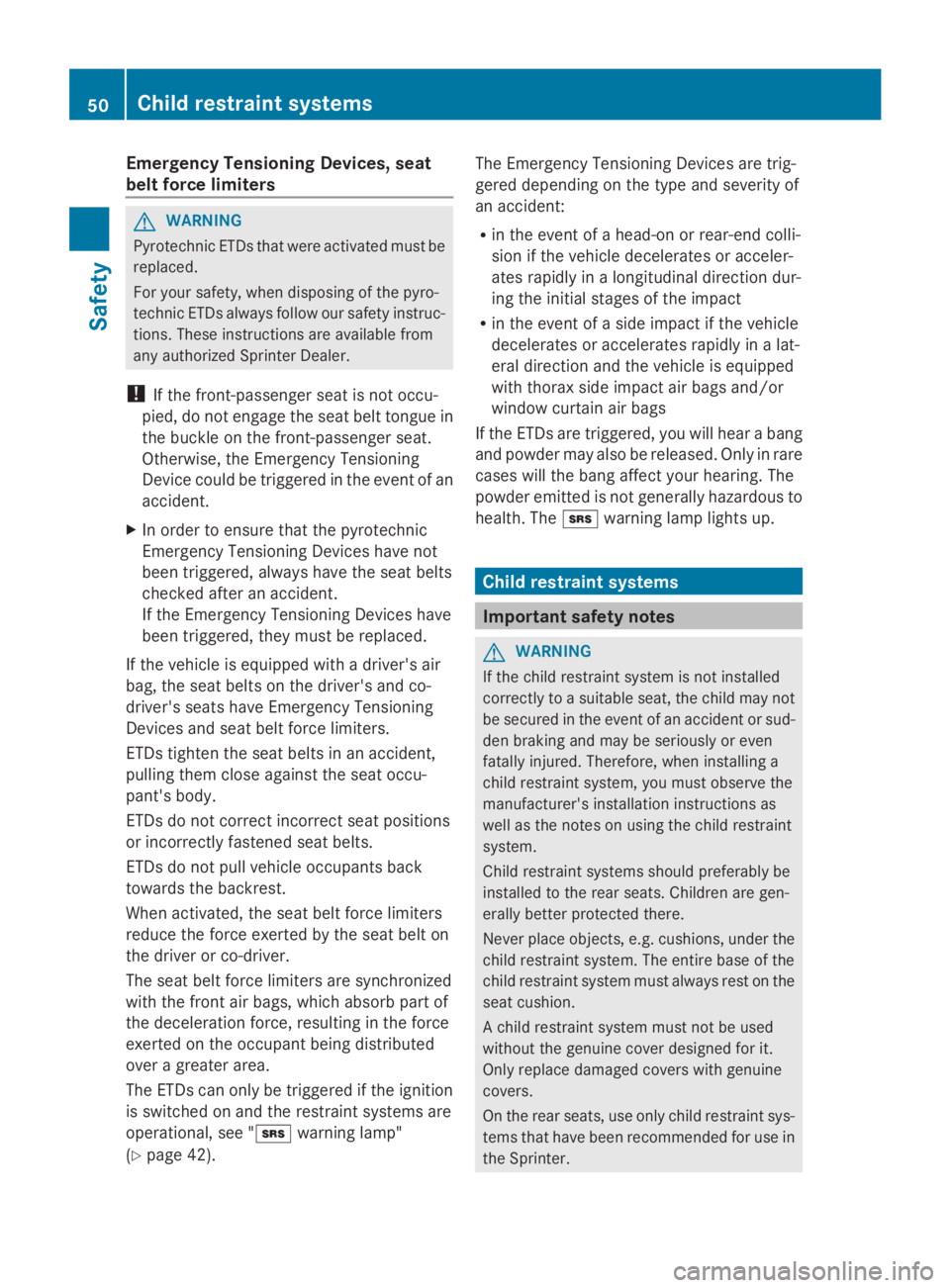
Emergency Tensioning Devices, seat
belt force limiters G
WARNING
Pyrotechnic ETDs that were activated must be
replaced.
For your safety, when disposing of the pyro-
technic ETDs always follow our safety instruc-
tions. These instructions are available from
any authorized Sprinter Dealer.
! If the front-passenger seat is not occu-
pied, do not engage the seat belt tongue in
the buckle on the front-passenger seat.
Otherwise, the Emergency Tensioning
Device could be triggered in the event of an
accident.
X In order to ensure that the pyrotechnic
Emergency Tensioning Devices have not
been triggered, always have the seat belts
checked after an accident.
If the Emergency Tensioning Devices have
been triggered, they must be replaced.
If the vehicle is equipped with a driver's air
bag, the seat belts on the driver's and co-
driver's seats have Emergency Tensioning
Devices and seat belt force limiters.
ETDs tighten the seat belts in an accident,
pulling them close against the seat occu-
pant's body.
ETDs do not correct incorrect seat positions
or incorrectly fastened seat belts.
ETDs do not pull vehicle occupants back
towards the backrest.
When activated, the seat belt force limiters
reduce the force exerted by the seat belt on
the driver or co-driver.
The seat belt force limiters are synchronized
with the front air bags, which absorb part of
the deceleration force, resulting in the force
exerted on the occupant being distributed
over a greater area.
The ETDs can only be triggered if the ignition
is switched on and the restraint systems are
operational, see " 007Ewarning lamp"
(Y page 42). The Emergency Tensioning Devices are trig-
gered depending on the type and severity of
an accident:
R
in the event of a head-on or rear-end colli-
sion if the vehicle decelerates or acceler-
ates rapidly in a longitudinal direction dur-
ing the initial stages of the impact
R in the event of a side impact if the vehicle
decelerates or accelerates rapidly in a lat-
eral direction and the vehicle is equipped
with thorax side impact air bags and/or
window curtain air bags
If the ETDs are triggered, you will hear a bang
and powder may also be released. Only in rare
cases will the bang affect your hearing. The
powder emitted is not generally hazardous to
health. The 007Ewarning lamp lights up. Child restraint systems
Important safety notes
G
WARNING
If the child restraint system is not installed
correctly to a suitable seat, the child may not
be secured in the event of an accident or sud-
den braking and may be seriously or even
fatally injured. Therefore, when installing a
child restraint system, you must observe the
manufacturer's installation instructions as
well as the notes on using the child restraint
system.
Child restraint systems should preferably be
installed to the rear seats. Children are gen-
erally better protected there.
Never place objects, e.g. cushions, under the
child restraint system. The entire base of the
child restraint system must always rest on the
seat cushion.
A child restraint system must not be used
without the genuine cover designed for it.
Only replace damaged covers with genuine
covers.
On the rear seats, use only child restraint sys-
tems that have been recommended for use in
the Sprinter. 50
Child restraint systemsSafety
Page 53 of 338
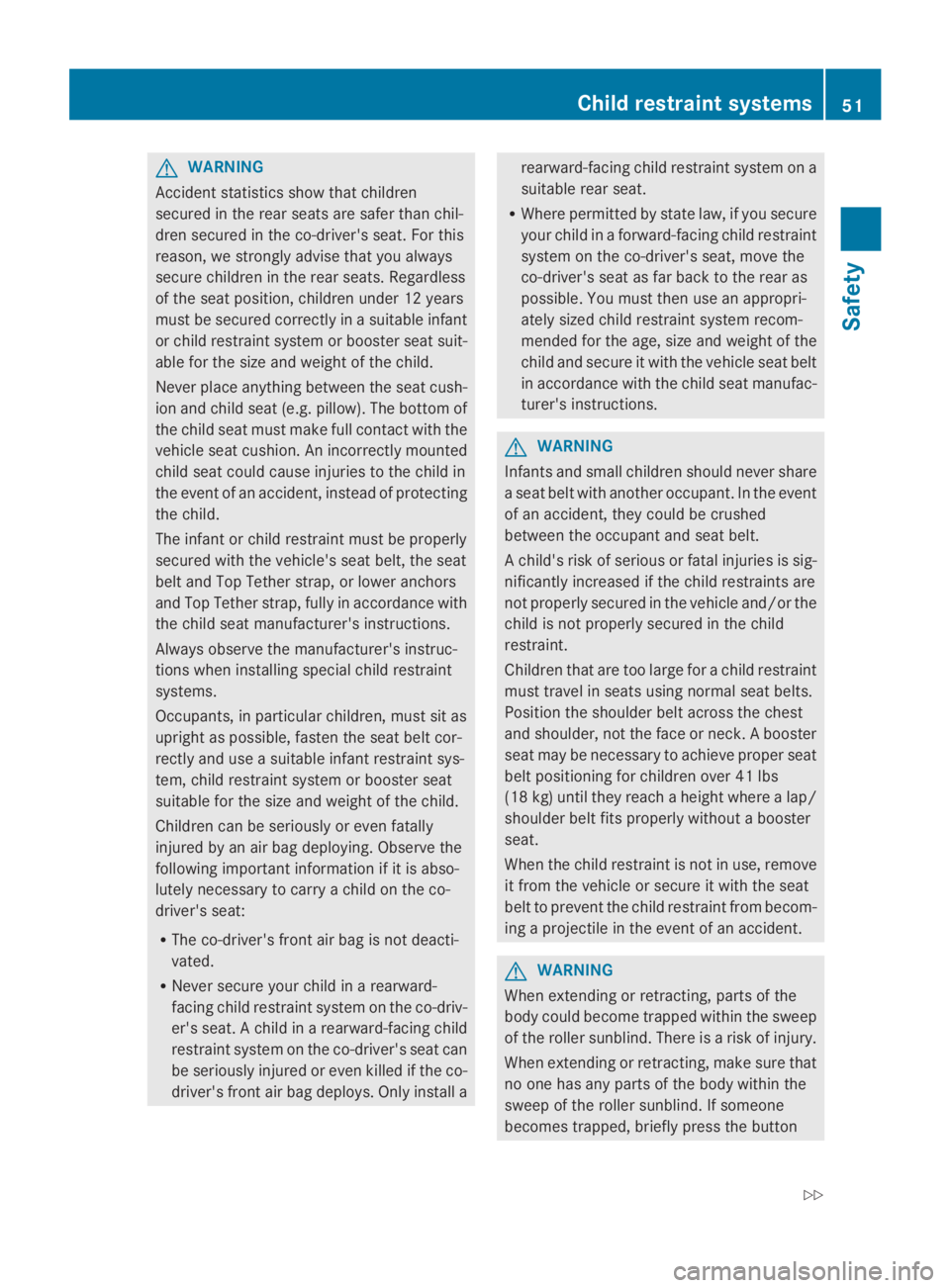
G
WARNING
Accident statistics show that children
secured in the rear seats are safer than chil-
dren secured in the co-driver's seat. For this
reason, we strongly advise that you always
secure children in the rear seats. Regardless
of the seat position, children under 12 years
must be secured correctly in a suitable infant
or child restraint system or booster seat suit-
able for the size and weight of the child.
Never place anything between the seat cush-
ion and child seat (e.g. pillow). The bottom of
the child seat must make full contact with the
vehicle seat cushion. An incorrectly mounted
child seat could cause injuries to the child in
the event of an accident, instead of protecting
the child.
The infant or child restraint must be properly
secured with the vehicle's seat belt, the seat
belt and Top Tether strap, or lower anchors
and Top Tether strap, fully in accordance with
the child seat manufacturer's instructions.
Always observe the manufacturer's instruc-
tions when installing special child restraint
systems.
Occupants, in particular children, must sit as
upright as possible, fasten the seat belt cor-
rectly and use a suitable infant restraint sys-
tem, child restraint system or booster seat
suitable for the size and weight of the child.
Children can be seriously or even fatally
injured by an air bag deploying. Observe the
following important information if it is abso-
lutely necessary to carry a child on the co-
driver's seat:
R The co-driver's front air bag is not deacti-
vated.
R Never secure your child in a rearward-
facing child restraint system on the co-driv-
er's seat. A child in a rearward-facing child
restraint system on the co-driver's seat can
be seriously injured or even killed if the co-
driver's front air bag deploys. Only install a rearward-facing child restraint system on a
suitable rear seat.
R Where permitted by state law, if you secure
your child in a forward-facing child restraint
system on the co-driver's seat, move the
co-driver's seat as far back to the rear as
possible. You must then use an appropri-
ately sized child restraint system recom-
mended for the age, size and weight of the
child and secure it with the vehicle seat belt
in accordance with the child seat manufac-
turer's instructions. G
WARNING
Infants and small children should never share
a seat belt with another occupant. In the event
of an accident, they could be crushed
between the occupant and seat belt.
A child's risk of serious or fatal injuries is sig-
nificantly increased if the child restraints are
not properly secured in the vehicle and/or the
child is not properly secured in the child
restraint.
Children that are too large for a child restraint
must travel in seats using normal seat belts.
Position the shoulder belt across the chest
and shoulder, not the face or neck. A booster
seat may be necessary to achieve proper seat
belt positioning for children over 41 lbs
(18 kg) until they reach a height where a lap/
shoulder belt fits properly without a booster
seat.
When the child restraint is not in use, remove
it from the vehicle or secure it with the seat
belt to prevent the child restraint from becom-
ing a projectile in the event of an accident. G
WARNING
When extending or retracting, parts of the
body could become trapped within the sweep
of the roller sunblind. There is a risk of injury.
When extending or retracting, make sure that
no one has any parts of the body within the
sweep of the roller sunblind. If someone
becomes trapped, briefly press the button Child restraint systems
51Safety
Z
Page 54 of 338
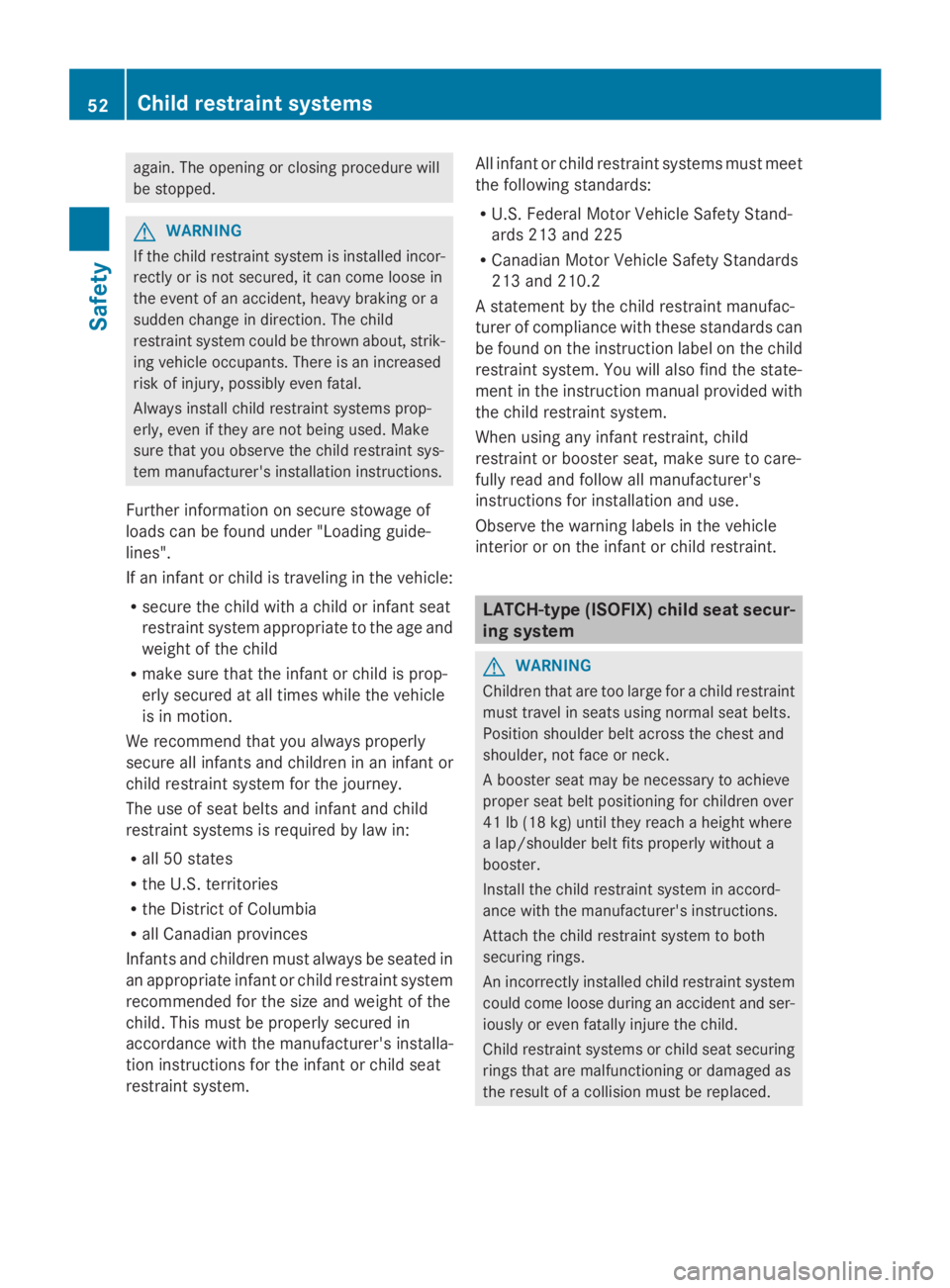
again. The opening or closing procedure will
be stopped. G
WARNING
If the child restraint system is installed incor-
rectly or is not secured, it can come loose in
the event of an accident, heavy braking or a
sudden change in direction. The child
restraint system could be thrown about, strik-
ing vehicle occupants. There is an increased
risk of injury, possibly even fatal.
Always install child restraint systems prop-
erly, even if they are not being used. Make
sure that you observe the child restraint sys-
tem manufacturer's installation instructions.
Further information on secure stowage of
loads can be found under "Loading guide-
lines".
If an infant or child is traveling in the vehicle:
R secure the child with a child or infant seat
restraint system appropriate to the age and
weight of the child
R make sure that the infant or child is prop-
erly secured at all times while the vehicle
is in motion.
We recommend that you always properly
secure all infants and children in an infant or
child restraint system for the journey.
The use of seat belts and infant and child
restraint systems is required by law in:
R all 50 states
R the U.S. territories
R the District of Columbia
R all Canadian provinces
Infants and children must always be seated in
an appropriate infant or child restraint system
recommended for the size and weight of the
child. This must be properly secured in
accordance with the manufacturer's installa-
tion instructions for the infant or child seat
restraint system. All infant or child restraint systems must meet
the following standards:
R
U.S. Federal Motor Vehicle Safety Stand-
ards 213 and 225
R Canadian Motor Vehicle Safety Standards
213 and 210.2
A statement by the child restraint manufac-
turer of compliance with these standards can
be found on the instruction label on the child
restraint system. You will also find the state-
ment in the instruction manual provided with
the child restraint system.
When using any infant restraint, child
restraint or booster seat, make sure to care-
fully read and follow all manufacturer's
instructions for installation and use.
Observe the warning labels in the vehicle
interior or on the infant or child restraint. LATCH-type (ISOFIX) child seat secur-
ing system
G
WARNING
Children that are too large for a child restraint
must travel in seats using normal seat belts.
Position shoulder belt across the chest and
shoulder, not face or neck.
A booster seat may be necessary to achieve
proper seat belt positioning for children over
41 lb (18 kg) until they reach a height where
a lap/shoulder belt fits properly without a
booster.
Install the child restraint system in accord-
ance with the manufacturer's instructions.
Attach the child restraint system to both
securing rings.
An incorrectly installed child restraint system
could come loose during an accident and ser-
iously or even fatally injure the child.
Child restraint systems or child seat securing
rings that are malfunctioning or damaged as
the result of a collision must be replaced. 52
Child restraint systemsSafety
Page 55 of 338
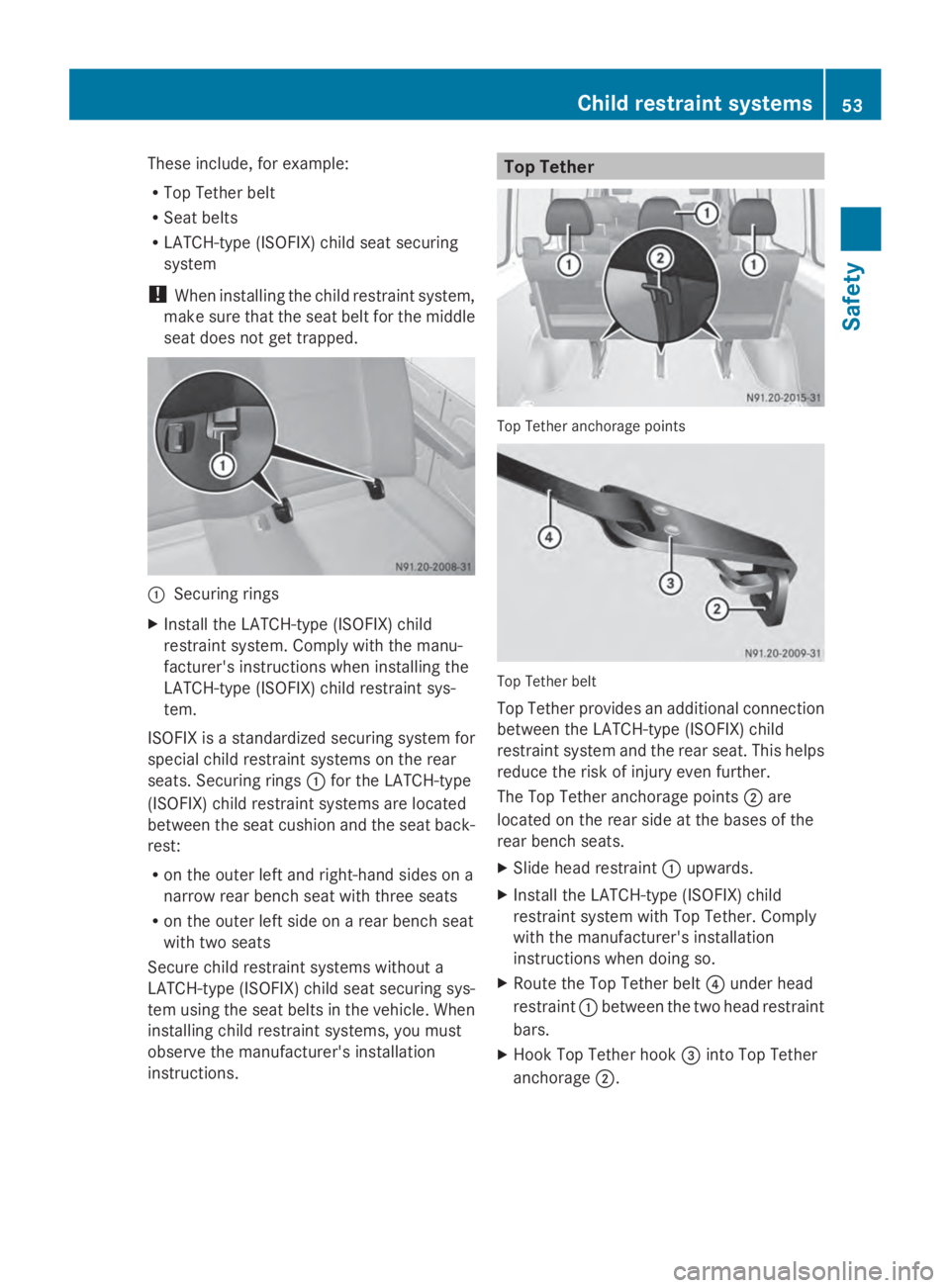
These include, for example:
R
Top Tether belt
R Seat belts
R LATCH-type (ISOFIX) child seat securing
system
! When installing the child restraint system,
make sure that the seat belt for the middle
seat does not get trapped. 0043
Securing rings
X Install the LATCH-type (ISOFIX) child
restraint system. Comply with the manu-
facturer's instructions when installing the
LATCH-type (ISOFIX) child restraint sys-
tem.
ISOFIX is a standardized securing system for
special child restraint systems on the rear
seats. Securing rings 0043for the LATCH-type
(ISOFIX) child restraint systems are located
between the seat cushion and the seat back-
rest:
R on the outer left and right-hand sides on a
narrow rear bench seat with three seats
R on the outer left side on a rear bench seat
with two seats
Secure child restraint systems without a
LATCH-type (ISOFIX) child seat securing sys-
tem using the seat belts in the vehicle. When
installing child restraint systems, you must
observe the manufacturer's installation
instructions. Top Tether
Top Tether anchorage points
Top Tether belt
Top Tether provides an additional connection
between the LATCH-type (ISOFIX) child
restraint system and the rear seat. This helps
reduce the risk of injury even further.
The Top Tether anchorage points
0044are
located on the rear side at the bases of the
rear bench seats.
X Slide head restraint 0043upwards.
X Install the LATCH-type (ISOFIX) child
restraint system with Top Tether. Comply
with the manufacturer's installation
instructions when doing so.
X Route the Top Tether belt 0085under head
restraint 0043between the two head restraint
bars.
X Hook Top Tether hook 0087into Top Tether
anchorage 0044. Child restraint systems
53Safety Z
Page 56 of 338
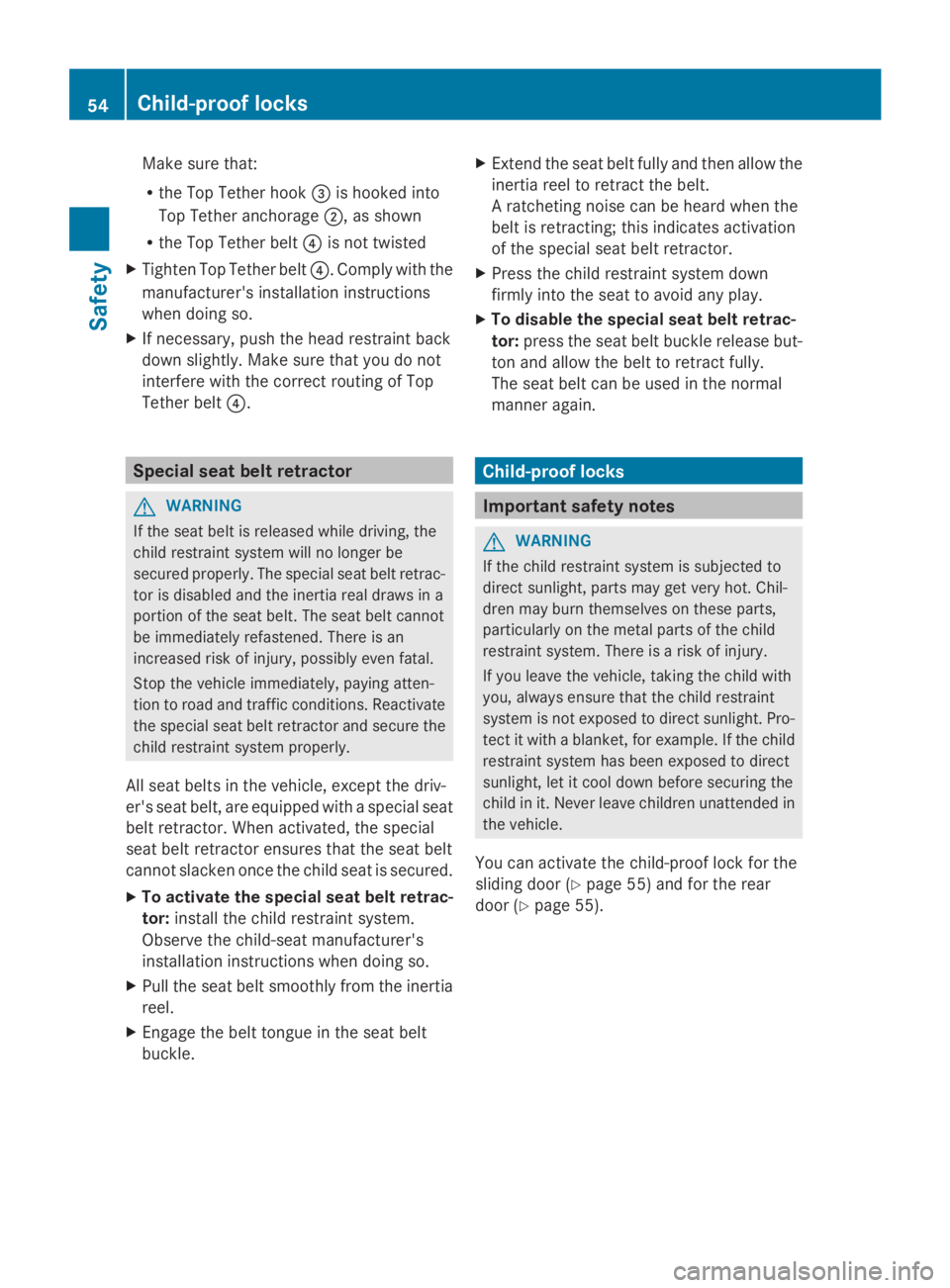
Make sure that:
R
the Top Tether hook 0087is hooked into
Top Tether anchorage 0044, as shown
R the Top Tether belt 0085is not twisted
X Tighten Top Tether belt 0085. Comply with the
manufacturer's installation instructions
when doing so.
X If necessary, push the head restraint back
down slightly. Make sure that you do not
interfere with the correct routing of Top
Tether belt 0085. Special seat belt retractor
G
WARNING
If the seat belt is released while driving, the
child restraint system will no longer be
secured properly. The special seat belt retrac-
tor is disabled and the inertia real draws in a
portion of the seat belt. The seat belt cannot
be immediately refastened. There is an
increased risk of injury, possibly even fatal.
Stop the vehicle immediately, paying atten-
tion to road and traffic conditions. Reactivate
the special seat belt retractor and secure the
child restraint system properly.
All seat belts in the vehicle, except the driv-
er's seat belt, are equipped with a special seat
belt retractor. When activated, the special
seat belt retractor ensures that the seat belt
cannot slacken once the child seat is secured.
X To activate the special seat belt retrac-
tor: install the child restraint system.
Observe the child-seat manufacturer's
installation instructions when doing so.
X Pull the seat belt smoothly from the inertia
reel.
X Engage the belt tongue in the seat belt
buckle. X
Extend the seat belt fully and then allow the
inertia reel to retract the belt.
A ratcheting noise can be heard when the
belt is retracting; this indicates activation
of the special seat belt retractor.
X Press the child restraint system down
firmly into the seat to avoid any play.
X To disable the special seat belt retrac-
tor: press the seat belt buckle release but-
ton and allow the belt to retract fully.
The seat belt can be used in the normal
manner again. Child-proof locks
Important safety notes
G
WARNING
If the child restraint system is subjected to
direct sunlight, parts may get very hot. Chil-
dren may burn themselves on these parts,
particularly on the metal parts of the child
restraint system. There is a risk of injury.
If you leave the vehicle, taking the child with
you, always ensure that the child restraint
system is not exposed to direct sunlight. Pro-
tect it with a blanket, for example. If the child
restraint system has been exposed to direct
sunlight, let it cool down before securing the
child in it. Never leave children unattended in
the vehicle.
You can activate the child-proof lock for the
sliding door (Y page 55) and for the rear
door (Y page 55). 54
Child-proof locksSafety
Page 57 of 338
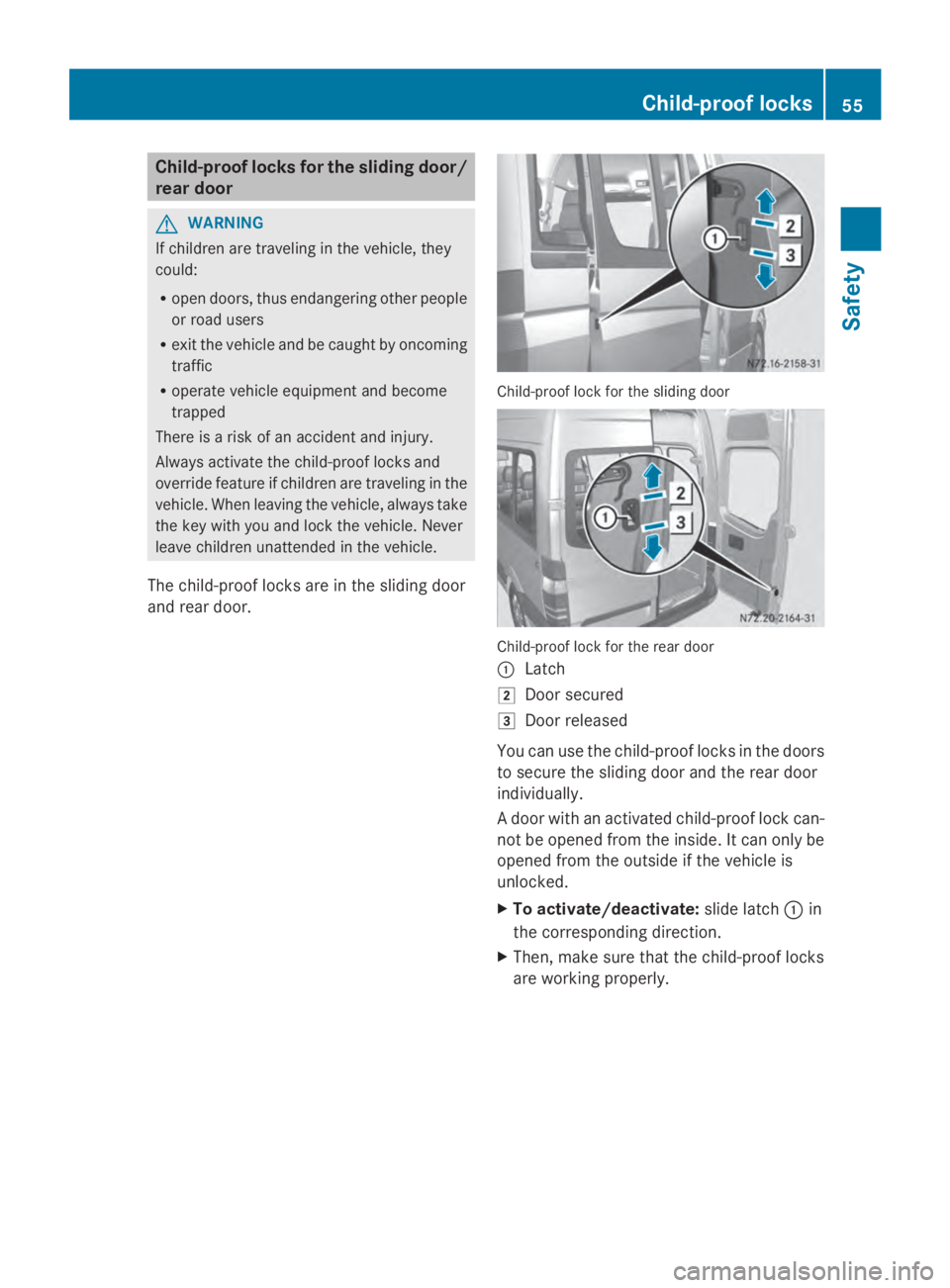
Child-proof locks for the sliding door/
rear door G
WARNING
If children are traveling in the vehicle, they
could:
R open doors, thus endangering other people
or road users
R exit the vehicle and be caught by oncoming
traffic
R operate vehicle equipment and become
trapped
There is a risk of an accident and injury.
Always activate the child-proof locks and
override feature if children are traveling in the
vehicle. When leaving the vehicle, always take
the key with you and lock the vehicle. Never
leave children unattended in the vehicle.
The child-proof locks are in the sliding door
and rear door. Child-proof lock for the sliding door
Child-proof lock for the rear door
0043
Latch
0048 Door secured
0049 Door released
You can use the child-proof locks in the doors
to secure the sliding door and the rear door
individually.
A door with an activated child-proof lock can-
not be opened from the inside. It can only be
opened from the outside if the vehicle is
unlocked.
X To activate/deactivate: slide latch0043in
the corresponding direction.
X Then, make sure that the child-proof locks
are working properly. Child-proof locks
55Safety Z
Page 58 of 338
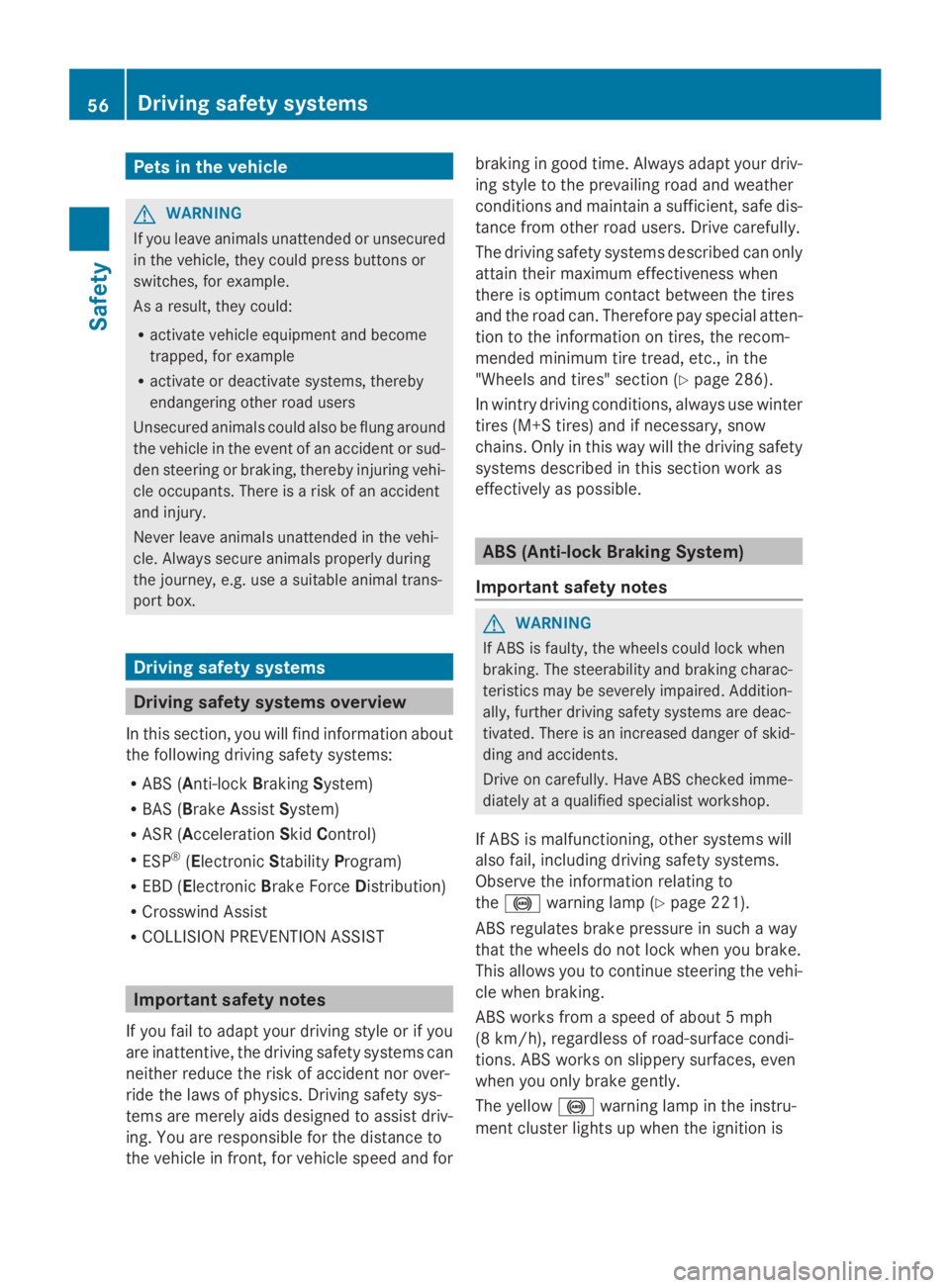
Pets in the vehicle
G
WARNING
If you leave animals unattended or unsecured
in the vehicle, they could press buttons or
switches, for example.
As a result, they could:
R activate vehicle equipment and become
trapped, for example
R activate or deactivate systems, thereby
endangering other road users
Unsecured animals could also be flung around
the vehicle in the event of an accident or sud-
den steering or braking, thereby injuring vehi-
cle occupants. There is a risk of an accident
and injury.
Never leave animals unattended in the vehi-
cle. Always secure animals properly during
the journey, e.g. use a suitable animal trans-
port box. Driving safety systems
Driving safety systems overview
In this section, you will find information about
the following driving safety systems:
R ABS (Anti-lock BrakingSystem)
R BAS (Brake AssistSystem)
R ASR (Acceleration SkidControl)
R ESP ®
(Electronic StabilityProgram)
R EBD ( Electronic Brake Force Distribution)
R Crosswind Assist
R COLLISION PREVENTION ASSIST Important safety notes
If you fail to adapt your driving style or if you
are inattentive, the driving safety systems can
neither reduce the risk of accident nor over-
ride the laws of physics. Driving safety sys-
tems are merely aids designed to assist driv-
ing. You are responsible for the distance to
the vehicle in front, for vehicle speed and for braking in good time. Always adapt your driv-
ing style to the prevailing road and weather
conditions and maintain a sufficient, safe dis-
tance from other road users. Drive carefully.
The driving safety systems described can only
attain their maximum effectiveness when
there is optimum contact between the tires
and the road can. Therefore pay special atten-
tion to the information on tires, the recom-
mended minimum tire tread, etc., in the
"Wheels and tires" section (Y
page 286).
In wintry driving conditions, always use winter
tires (M+S tires) and if necessary, snow
chains. Only in this way will the driving safety
systems described in this section work as
effectively as possible. ABS (Anti-lock Braking System)
Important safety notes G
WARNING
If ABS is faulty, the wheels could lock when
braking. The steerability and braking charac-
teristics may be severely impaired. Addition-
ally, further driving safety systems are deac-
tivated. There is an increased danger of skid-
ding and accidents.
Drive on carefully. Have ABS checked imme-
diately at a qualified specialist workshop.
If ABS is malfunctioning, other systems will
also fail, including driving safety systems.
Observe the information relating to
the 0025 warning lamp (Y page 221).
ABS regulates brake pressure in such a way
that the wheels do not lock when you brake.
This allows you to continue steering the vehi-
cle when braking.
ABS works from a speed of about 5 mph
(8 km/h), regardless of road-surface condi-
tions. ABS works on slippery surfaces, even
when you only brake gently.
The yellow 0025warning lamp in the instru-
ment cluster lights up when the ignition is 56
Driving safety systemsSafety
Page 59 of 338
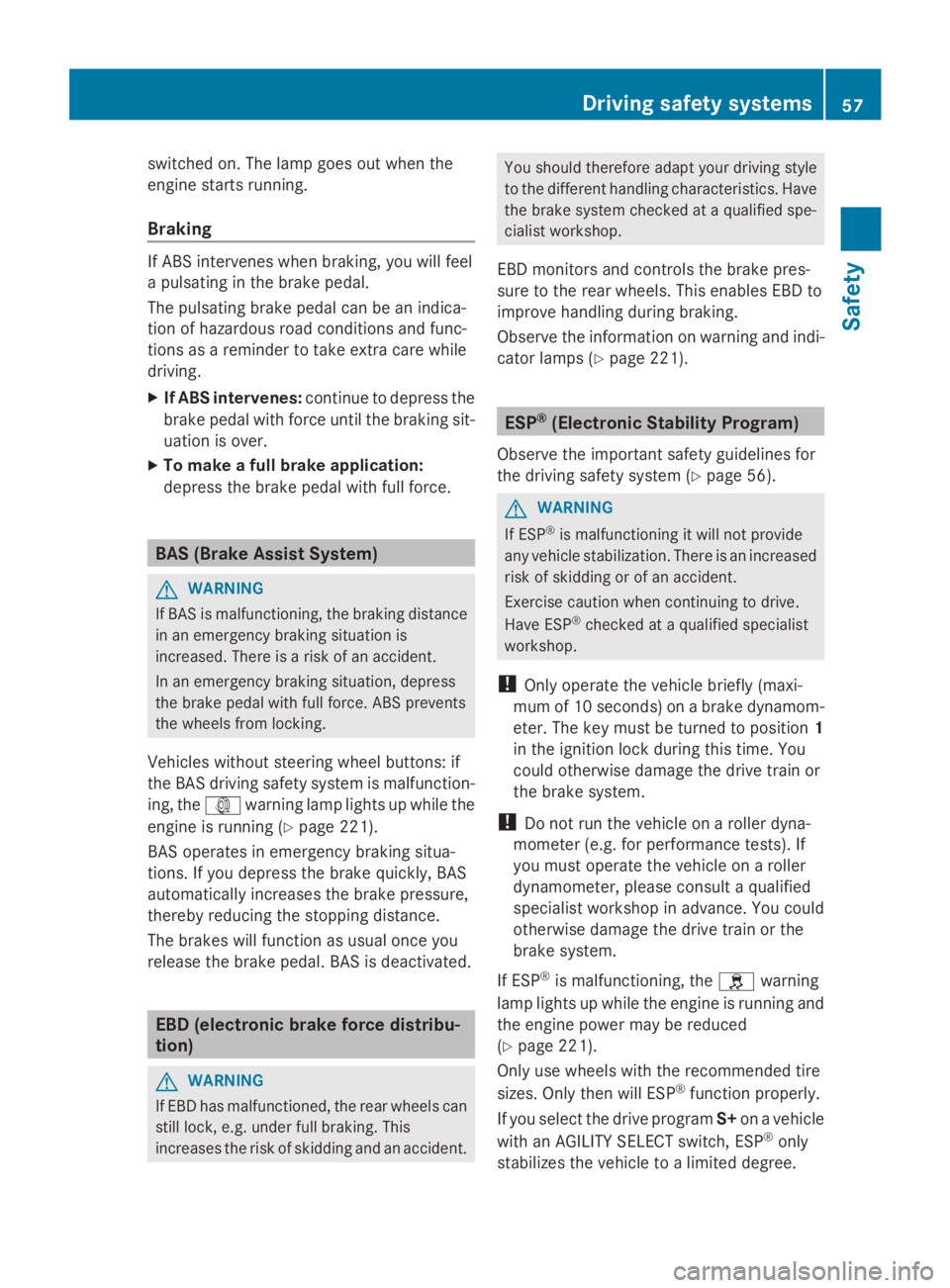
switched on. The lamp goes out when the
engine starts running.
Braking If ABS intervenes when braking, you will feel
a pulsating in the brake pedal.
The pulsating brake pedal can be an indica-
tion of hazardous road conditions and func-
tions as a reminder to take extra care while
driving.
X If ABS intervenes: continue to depress the
brake pedal with force until the braking sit-
uation is over.
X To make a full brake application:
depress the brake pedal with full force. BAS (Brake Assist System)
G
WARNING
If BAS is malfunctioning, the braking distance
in an emergency braking situation is
increased. There is a risk of an accident.
In an emergency braking situation, depress
the brake pedal with full force. ABS prevents
the wheels from locking.
Vehicles without steering wheel buttons: if
the BAS driving safety system is malfunction-
ing, the 003Dwarning lamp lights up while the
engine is running (Y page 221).
BAS operates in emergency braking situa-
tions. If you depress the brake quickly, BAS
automatically increases the brake pressure,
thereby reducing the stopping distance.
The brakes will function as usual once you
release the brake pedal. BAS is deactivated. EBD (electronic brake force distribu-
tion)
G
WARNING
If EBD has malfunctioned, the rear wheels can
still lock, e.g. under full braking. This
increases the risk of skidding and an accident. You should therefore adapt your driving style
to the different handling characteristics. Have
the brake system checked at a qualified spe-
cialist workshop.
EBD monitors and controls the brake pres-
sure to the rear wheels. This enables EBD to
improve handling during braking.
Observe the information on warning and indi-
cator lamps (Y page 221). ESP
®
(Electronic Stability Program)
Observe the important safety guidelines for
the driving safety system (Y page 56). G
WARNING
If ESP ®
is malfunctioning it will not provide
any vehicle stabilization. There is an increased
risk of skidding or of an accident.
Exercise caution when continuing to drive.
Have ESP ®
checked at a qualified specialist
workshop.
! Only operate the vehicle briefly (maxi-
mum of 10 seconds) on a brake dynamom-
eter. The key must be turned to position 1
in the ignition lock during this time. You
could otherwise damage the drive train or
the brake system.
! Do not run the vehicle on a roller dyna-
mometer (e.g. for performance tests). If
you must operate the vehicle on a roller
dynamometer, please consult a qualified
specialist workshop in advance. You could
otherwise damage the drive train or the
brake system.
If ESP ®
is malfunctioning, the 0089warning
lamp lights up while the engine is running and
the engine power may be reduced
(Y page 221).
Only use wheels with the recommended tire
sizes. Only then will ESP ®
function properly.
If you select the drive program S+on a vehicle
with an AGILITY SELECT switch, ESP ®
only
stabilizes the vehicle to a limited degree. Driving safety systems
57Safety Z
Page 60 of 338
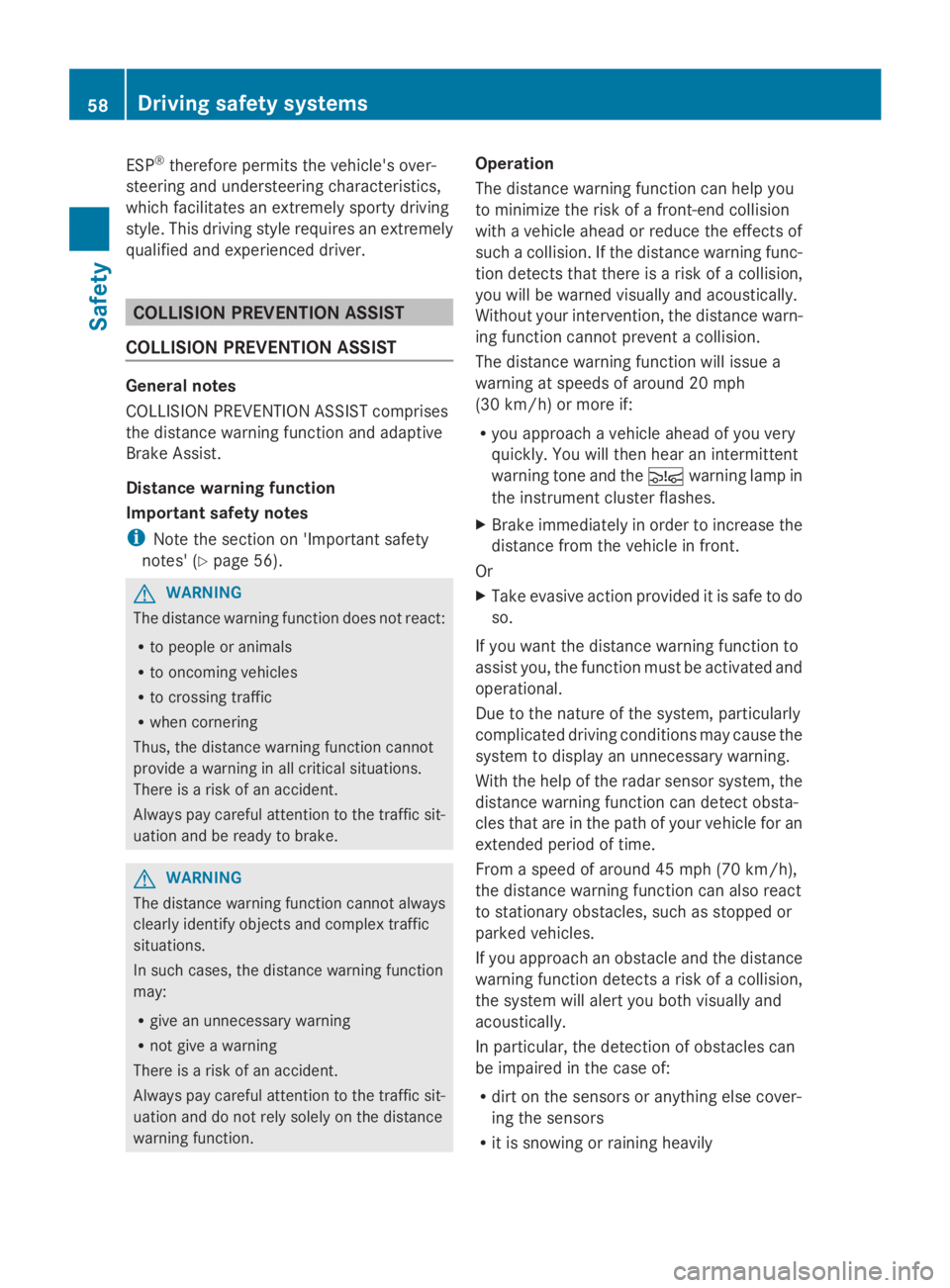
ESP
®
therefore permits the vehicle's over-
steering and understeering characteristics,
which facilitates an extremely sporty driving
style. This driving style requires an extremely
qualified and experienced driver. COLLISION PREVENTION ASSIST
COLLISION PREVENTION ASSIST General notes
COLLISION PREVENTION ASSIST comprises
the distance warning function and adaptive
Brake Assist.
Distance warning function
Important safety notes
i Note the section on 'Important safety
notes' ( Ypage 56). G
WARNING
The distance warning function does not react:
R to people or animals
R to oncoming vehicles
R to crossing traffic
R when cornering
Thus, the distance warning function cannot
provide a warning in all critical situations.
There is a risk of an accident.
Always pay careful attention to the traffic sit-
uation and be ready to brake. G
WARNING
The distance warning function cannot always
clearly identify objects and complex traffic
situations.
In such cases, the distance warning function
may:
R give an unnecessary warning
R not give a warning
There is a risk of an accident.
Always pay careful attention to the traffic sit-
uation and do not rely solely on the distance
warning function. Operation
The distance warning function can help you
to minimize the risk of a front-end collision
with a vehicle ahead or reduce the effects of
such a collision. If the distance warning func-
tion detects that there is a risk of a collision,
you will be warned visually and acoustically.
Without your intervention, the distance warn-
ing function cannot prevent a collision.
The distance warning function will issue a
warning at speeds of around 20 mph
(30 km/h) or more if:
R
you approach a vehicle ahead of you very
quickly. You will then hear an intermittent
warning tone and the 00C7warning lamp in
the instrument cluster flashes.
X Brake immediately in order to increase the
distance from the vehicle in front.
Or
X Take evasive action provided it is safe to do
so.
If you want the distance warning function to
assist you, the function must be activated and
operational.
Due to the nature of the system, particularly
complicated driving conditions may cause the
system to display an unnecessary warning.
With the help of the radar sensor system, the
distance warning function can detect obsta-
cles that are in the path of your vehicle for an
extended period of time.
From a speed of around 45 mph (70 km/h),
the distance warning function can also react
to stationary obstacles, such as stopped or
parked vehicles.
If you approach an obstacle and the distance
warning function detects a risk of a collision,
the system will alert you both visually and
acoustically.
In particular, the detection of obstacles can
be impaired in the case of:
R dirt on the sensors or anything else cover-
ing the sensors
R it is snowing or raining heavily 58
Driving safety systemsSafety